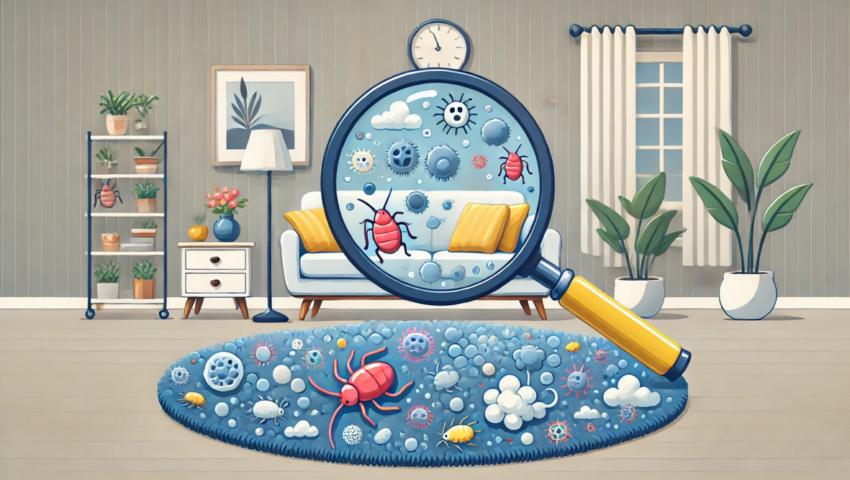Dust Mites: The Tiny Tenants That Never Pay Rent
If you have a carpet, you also have roommates—millions of them. Dust mites are microscopic creatures that thrive in warm, humid environments and feast on dead skin cells. And guess what? Your carpet is their personal buffet. While they themselves aren’t harmful, their droppings contain proteins that trigger allergies, asthma, and general respiratory misery.Regular vacuuming helps, but if you really want to evict these freeloaders, you’ll need to steam clean your carpets. High temperatures are their kryptonite, and a deep clean every few months will help keep their numbers in check. For bonus points, invest in a HEPA filter vacuum—because the last thing you want is a vacuum that just redistributes them like confetti at an allergy convention.
Bacteria: Your Carpet’s Secret Science Experiment
Your carpet is basically a petri dish that covers your entire floor. Researchers have found that carpets can be 4,000 times dirtier than a toilet seat. That’s right—you’d be better off eating dinner off your toilet than your carpet. (Not that I’d recommend either.)What kinds of bacteria are we talking about? Well, if you’ve ever walked inside with shoes, you might be tracking in E. coli from public restrooms, Salmonella from questionable street puddles, and Staphylococcus, which sounds fancy but isn’t something you want multiplying under your feet.
The solution? Remove your shoes at the door—your carpet and immune system will thank you. Also, deep cleaning isn’t just for when you spill spaghetti sauce. Regular steam cleaning kills bacteria, and using a non-toxic carpet disinfectant can add an extra layer of defense.
Mold: The Unwanted Houseguest That Never Leaves
Mold is the Houdini of household invaders—it thrives in damp conditions and is a master of disguise. If your carpet has ever been wet for too long (thanks to spills, leaks, or overly enthusiastic mopping), mold spores may have taken up residence beneath the surface.Breathing in mold spores can lead to sneezing, coughing, and a general sense of malaise, especially for those with respiratory issues. The worst part? You may not even see it. Mold loves to hide under carpets, where it spreads its kingdom of doom unnoticed.
Preventing mold is simple: keep your carpets dry, use a dehumidifier if your home is prone to moisture, and don’t ignore spills. If your carpet does get soaked, drying it quickly (preferably with fans or a wet/dry vacuum) can keep the spores from throwing a housewarming party.
Toxins: Your Carpet’s Unseen Chemical Cocktail
If you think your carpet is just fabric and fluff, think again. Many carpets are treated with stain repellents, flame retardants, and adhesives that can off-gas volatile organic compounds (VOCs) into the air. These VOCs can contribute to headaches, dizziness, and even long-term health issues if exposure is constant.And let’s not forget about the pesticides, heavy metals, and other pollutants that hitch a ride on your shoes and settle into the fibers. Your carpet isn’t just a comfy place to sit—it’s a sponge soaking up everything from car exhaust to lawn chemicals.
How do you fight back? Start with eco-friendly cleaning solutions, avoid synthetic air fresheners that just add more chemicals to the mix, and, if you’re in the market for a new carpet, look for low-VOC options. Oh, and once again—shoes off at the door. (Are you seeing a theme here?)
Pets: The Adorable Yet Unsanitary Contributors
We love our furry friends, but let’s be honest—they’re not the most hygienic housemates. Pet dander, hair, and the occasional “accident” all contribute to a carpet that’s basically a biohazard zone in disguise.Pet dander, in particular, is a major allergen, and it doesn’t just stay put. It floats through the air, lands on furniture, and somehow finds its way into every corner of your home. Vacuuming with a pet-friendly HEPA filter vacuum helps, as does regular grooming. And if your pet has a habit of turning your carpet into a personal restroom, enzymatic cleaners are your best friend—they break down odors at a molecular level instead of just masking them.
Breathing Easy: The Path to a Healthier Carpet
So, what’s the best way to ensure your carpet isn’t a biological threat? A few key habits can make all the difference:- Vacuum at least twice a week with a HEPA filter vacuum.
- Deep clean carpets every 3-6 months using steam or a professional service.
- Use natural, non-toxic cleaners to minimize chemical exposure.
- Keep moisture levels low to prevent mold and mildew growth.
- Encourage a shoes-off policy to reduce dirt and toxins entering the home.
Rolling Out the (Clean) Carpet
Your carpet might be a silent accomplice in harboring allergens, bacteria, and questionable substances, but with a little effort, you can reclaim your floors. Think of it this way—every time you deep clean, you’re not just removing dirt; you’re evicting an army of microscopic squatters.So, the next time you drop a snack on the carpet and consider the five-second rule… maybe reconsider. And then grab the vacuum.
Article kindly provided by allprochemdry.com


